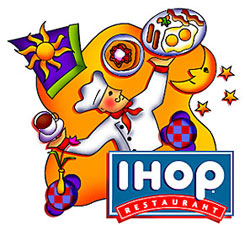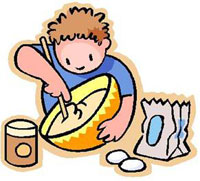 Before there was IHOP, there was Gwynn’s.
Before there was IHOP, there was Gwynn’s.
When I was a kid in suburban Teaneck, New Jersey, it was always a treat to go for Sunday brunch with my family at Gwynn’s on Teaneck Road. Gwynn’s seemed swanky and grown-up to me. Outside, it was painted white brick, and inside it was cool and darkish, with comfy booths. My mother would order her coffee, and the cream came in tiny, glass pitchers with little round cardboard pull-tabs on top. She only used a drop and then gave me the supreme pleasure of letting me drink the rest of the cream from its miniature jar. Sometimes, if she had a second cup, I got another taste of the thick, heavenly liquid that would contribute to the need for Lipitor years later. Compared to my very picky little sister, who ate only cream cheese and jelly, I was “a good eater” with a passion for pancakes, waffles and French toast.

 So, we had this awesome carrot cake down on Cumberland Island last November for our father’s birthday…the cake was baked and smuggled onto the island by Julie, Daddy’s wife and our new personal gourmet chef! This cake is unbelievably good and it is one of those dishes that lingers in your mind long after the last crumbs have been eaten. Obviously so, since I had the cake back in November and I was still reeling about it come February. I had to make the cake…I had to make the cake Julie’s way, so, I did. I followed her tweaks and tips for a successful cake and boy oh boy was it!
So, we had this awesome carrot cake down on Cumberland Island last November for our father’s birthday…the cake was baked and smuggled onto the island by Julie, Daddy’s wife and our new personal gourmet chef! This cake is unbelievably good and it is one of those dishes that lingers in your mind long after the last crumbs have been eaten. Obviously so, since I had the cake back in November and I was still reeling about it come February. I had to make the cake…I had to make the cake Julie’s way, so, I did. I followed her tweaks and tips for a successful cake and boy oh boy was it! When I was a kid, I was pretty much a geek. At nine I started to
stutter so badly that the school put me into a class for “special”
students and my parents sent me to a psychologist. The approach
favored by the psychologist was to withhold talking until I said
something. Since I didn’t want to stutter and didn’t want to talk to
him anyway, we mostly spent 50 minutes in silence.
When I was a kid, I was pretty much a geek. At nine I started to
stutter so badly that the school put me into a class for “special”
students and my parents sent me to a psychologist. The approach
favored by the psychologist was to withhold talking until I said
something. Since I didn’t want to stutter and didn’t want to talk to
him anyway, we mostly spent 50 minutes in silence. Last night my husband Rob and I attended a meeting of the East Lansing City’s Planning Commission (because we know how to have a good time) which started at 7:00. These meetings, or at least the part with which we are concerned, usually end by 8:30 or 9:00, so we left Sam Home Alone. He is 11, we were literally 3 minutes away, and there were neighbors home.
Last night my husband Rob and I attended a meeting of the East Lansing City’s Planning Commission (because we know how to have a good time) which started at 7:00. These meetings, or at least the part with which we are concerned, usually end by 8:30 or 9:00, so we left Sam Home Alone. He is 11, we were literally 3 minutes away, and there were neighbors home. There’s no question my husband loves his daughter, his dog and me – and no question, in that order – but he is not sentimental. He’s got his moments – as in, let’s dump my high school notes, let’s save his 80′s matchbooks – but on the whole, what Greg likes best is the ca-chunk of the recycling bin. Or better yet, the trash.
There’s no question my husband loves his daughter, his dog and me – and no question, in that order – but he is not sentimental. He’s got his moments – as in, let’s dump my high school notes, let’s save his 80′s matchbooks – but on the whole, what Greg likes best is the ca-chunk of the recycling bin. Or better yet, the trash.
